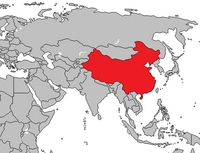The current global atheist population mostly resides in East Asia (particularly China) and in secular Europe/Australia primarily among whites.[1] See: Global atheism and Asian atheism and Secular Europe and Western atheism and race
Contents
Religion and control of diabetes[edit]
Medscape reported in 2017: "Religious beliefs can affect how diabetic patients and their spouses cope with the stress of diabetes, with positive attitudes resulting in good lifestyle habits that result in greater success with glycemic control for the diabetic spouse, new US research indicates.'[2]
The abstract for the 2011 medical journal article Does religious affiliation influence glycaemic control in primary care patients with type 2 diabetes mellitus? published in the journal Mental Health in Family Medicine indicates: "Those with higher religiosity amongst the Moslem population had significantly better glycaemic control. Patients who had church-going religions had better glycaemic control compared with those of other religions."[3]
Secular Europe and diabetes[edit]
See also: Secular Europe

From a global perspective, Europe is more secular/atheistic than the rest of the world although it does have a considerable amount of religious immigrants who have significantly higher birth rates (see: Secular Europe and Atheist population and Global atheism).
According to the World Health Organization (WHO):
| “ | There are about 60 million people with diabetes in the European Region, or about 10.3% of men and 9.6% of women aged 25 years and over.
Prevalence of diabetes is increasing among all ages in the European Region, mostly due to increases in overweight and obesity, unhealthy diet and physical inactivity. Worldwide, high blood glucose kills about 3.4 million people annually. Almost 80% of these deaths occur in low- and middle-income countries, and almost half are people aged under 70 years. WHO projects diabetes deaths will double between 2005 and 2030.[5] |
” |
Secular Europe and obesity[edit]
See also: Secular Europe and obesity and Atheism and obesity

Individuals who are overweight/obese have added pressure on their body's ability to use insulin to properly control blood sugar levels. Therefore, they are more likely to develop diabetes.[7]
The World Health Organization (WHO) recently reported:
| “ | Based on the latest estimates in European Union countries, overweight affects 30-70% and obesity affects 10-30% of adults.
Estimates of the number of overweight infants and children in the WHO European Region rose steadily from 1990 to 2008. Over 60% of children who are overweight before puberty will be overweight in early adulthood.[8] |
” |
For more information, please see:
Atheist controlled mainland China and diabetes[edit]
See also: China and atheism

Atheism and China[edit]
See also: China and atheism
China has the world's largest atheist population.[10][11] China practices state atheism (see: China and atheism).
East Asia contains about 25 percent of the world’s population. China’s population represents 20 percent of the people on earth.[12]
Razib Khan points out in Discover Magazine, "most secular nations in the world are those of East Asia, in particular what are often termed “Confucian societies.” It is likely therefore that the majority of the world’s atheists are actually East Asian."[13] See: Asian atheism and Global atheism
Diabetes in China[edit]
In 2016, Quartz reported:
| “ | Shi is one of millions of people caught in China’s diabetes epidemic. In the 1980s diabetes was a rarity affecting just one percent of China’s population. Now, due to rapid economic development, and the subsequent growth in availability of high-calorie diets, cars and sedentary lifestyles, China has the highest number of diabetics in the world, totaling 109 million people in 2015—roughly 11 percent of the population. That makes China home to a third of the world’s diabetic population. The scale of this public health problem is huge, particularly because it comes at a time when the country’s health system as a whole is under reform, moving from a rudimentary socialist system to one that is open to private investment and ownership. Currently, access to health care varies greatly by location and economic status, but long lines outside hospitals are a common sight, in part due to a growing ageing population.[14] | ” |
China and obesity[edit]
See also: China and obesity
In 2014, it was reported that China's obesity rate has skyrocketed in the last 30 years and the Chinese now have the second highest obesity rate in the world.[18][19] The Wall Street Journal reported in 2014 that China had approximately 300 million overweight people.[20] In 2014, the British medical journal Lancet analyzed weight trends in 188 countries and reported that more than 28% of Chinese adult men and 27% of the country’s adult women are now overweight or obese.[21]
According to a 2012 report by the Chinese Center for Disease Control and Prevention, the number of obese children in China has reached 120 million.[22] A recent study published in the Obesity Reviews journal, found that Chinese teenagers' rate of diabetes was four times that of their American peers.[23] Due to their past one-child policy, which had exceptions, China now has a lot of over-pampered and over-fed children.[24]
Matthew Crabbe, co-author of "Fat China: How Expanding Waistlines are Changing a Nation" declared that China's surging rate of obesity is "a ticking bomb" underneath the country's future economic growth and healthcare system.[25]
In 2014, The Economist declared in an article entitled Chubby little emperors:
| “ | MORE than 2,000 years ago “Huangdi Neijing”, a classic Chinese medical text, identified obesity as a disease caused by eating too much “fatty meats and polished grains”. Until a generation ago such a diet was an extravagance beyond imagination for all but the elite. But the Chinese waistline has since expanded, and at an alarming rate.
More than a quarter of the adult population, or roughly 350m people, is overweight or obese (more than 60m squeeze into the latter camp). That is at least twice as many as are under-nourished. With rising incomes and more diverse diets, Chinese people are consuming much more fatty food and fizzy drinks. Meals now contain more than twice as much oil and meats as in the 1980s. This is producing a health calamity, both in heart disease (which now accounts for over a third of deaths) and in a less-noticed explosion of diabetes, which is closely linked to obesity. The prevalence of diabetes has grown more than tenfold during the past three decades. According to a recent national survey, 11.6% of Chinese adults are diabetic, a share almost as high as in America, whose obesity rate is much greater. With a catastrophic famine still in living memory, it is little surprise that Chinese people have developed a taste for foods rich in fats and sugars.[26] |
” |
Irreligion, Australia and diabetes[edit]
Irreligion and Australia[edit]
See also: Irreligion in Australia
After WWII, Australia has become a very secular country.[29]
According to the Sydney Morning Herald:
| “ | Australia is one of the least devout countries in the Western world, although two-thirds of its population identifies itself as Christian, an international survey comparing religious expression in 21 countries has found.
Religion does not play a central part in the lives of many Australians: 48 per cent of Australians surveyed said they did not partake in personal prayer and 52 per cent said they rarely attended a place of worship for religious reasons.[30] |
” |
Diabetes in Australia[edit]
According to the website Diabetes Australia:
| “ | Diabetes is the epidemic of the 21st century and the biggest challenge confronting Australia’s health system.
280 Australians develop diabetes every day. That’s one person every five minutes Around 1.7 million Australians have diabetes. This includes all types of diagnosed diabetes (1.2 million known and registered) as well as silent, undiagnosed type 2 diabetes (up to 500,000 estimated). More than 100,000 Australians have developed diabetes in the past year. For every person diagnosed with diabetes there is usually a family member or carer who also ‘lives with diabetes’ every day in a support role. This means that an estimated 2.4 million Australians are affected by diabetes every day. Total annual cost impact of diabetes in Australia estimated at $14.6 billion.[31] |
” |
Obesity in Australia[edit]
In November of 2017, the Australian government website Australian Institute of Health and Welfare reported: "Almost one-quarter of children and two-thirds of adults are overweight or obese, and rates continue to rise, largely due to a rise in obesity, which cost the economy $8.6 billion in 2011–12."[32]
See also[edit]
- Atheism and obesity
- Atheism and sedentary lifestyles
- Atheism and health
- Atheism and life expectancy
- Atheism and cancer
- Atheism and Alzheimer's disease
- Atheism and alcoholism
- Atheism and smoking
- Atheism and drug addiction
- Atheism and mental illness
Notes[edit]
- ↑ A surprising map of where the world’s atheists live, By Max Fisher and Caitlin Dewey, Washington Post, May 23, 2013
- ↑ Religion Shapes Glucose Control in Marriages With Diabetes, Medscape, 2017
- ↑ Does religious affiliation influence glycaemic control in primary care patients with type 2 diabetes mellitus?, Chew Boon How, MD MFam Med,corresponding author Khoo Ee Ming, MRCGP MD, and Chia Yook Chin, MBBS FRCP, Ment Health Fam Med. 2011 Mar; 8(1): 21–28. PMCID: PMC3134210, PMID: 22479289
- ↑ World Health Organization - Regional Office for Europe - The challenge of obesity - quick statistics
- ↑ World Health Organization - Europe - Diabetes
- ↑ Your Weight and Diabetes http://tosconnect.obesity.org/obesity/content/weight-diabetes
- ↑ Your Weight and Diabetes http://tosconnect.obesity.org/obesity/content/weight-diabetes
- ↑ World Health Organization - Regional Office for Europe - The challenge of obesity - quick statistics
- ↑ [The looming public health crises threatening to take down China’s health care system], Quartz, 2016
- ↑ Top 50 Countries With Highest Proportion of Atheists / Agnostics (Zuckerman, 2005)
- ↑ A surprising map of where the world’s atheists live, Washington Post By Max Fisher and Caitlin Dewey May 23, 2013
- ↑ The Growth of Christianity in East Asia
- ↑ Most atheists are not white & other non-fairy tales, Discover magazine
- ↑ [The looming public health crises threatening to take down China’s health care system], Quartz, 2016
- ↑ As Obesity Rises, Chinese Kids Are Almost as Fat as Americans, Wall Street Journal Chinarealtime, May 29, 2014
- ↑ Chubby China: Nation of 300 Million Overweight People
- ↑ Obesity is a growing concern in China By Pang Li, China.org.cn, September 14, 2012
- ↑ As Obesity Rises, Chinese Kids Are Almost as Fat as Americans, Wall Street Journal Chinarealtime, May 29, 2014
- ↑ Chubby China: Nation of 300 Million Overweight People
- ↑ Chubby China: Nation of 300 Million Overweight People
- ↑ As Obesity Rises, Chinese Kids Are Almost as Fat as Americans, Wall Street Journal Chinarealtime, May 29, 2014
- ↑ Child Obesity Reaches 120 Million in China
- ↑ Obesity is a growing concern in China By Pang Li, China.org.cn, September 14, 2012
- ↑ Rising Chinese Child Obesity and Fat Camps
- ↑ Obesity is a growing concern in China By Pang Li, China.org.cn, September 14, 2012
- ↑ Chubby little emperors, The Economist, June 14th 2014|BEIJING|From the print edition
- ↑ WORLD RANKING OF COUNTRIES BY THEIR AVERAGE
- ↑ Are we becoming more STUPID? IQ scores are decreasing - and some experts argue it's because humans have reached their intellectual peak, Daily Mail, 2014
- ↑ Stephanie Painter, Vivienne Ryan and Bethany Hiatt, (15 June 2010). "Australians losing the faith". Newspaper. West Australian Newspapers Ltd. Retrieved 15 June 2010
- ↑ God's OK, it's just the religion bit we don't like
- ↑ Diabetes in Australia
- ↑ A picture of overweight and obesity in Australia, Australian Institute of Health and Welfare, 24 Nov 2017

